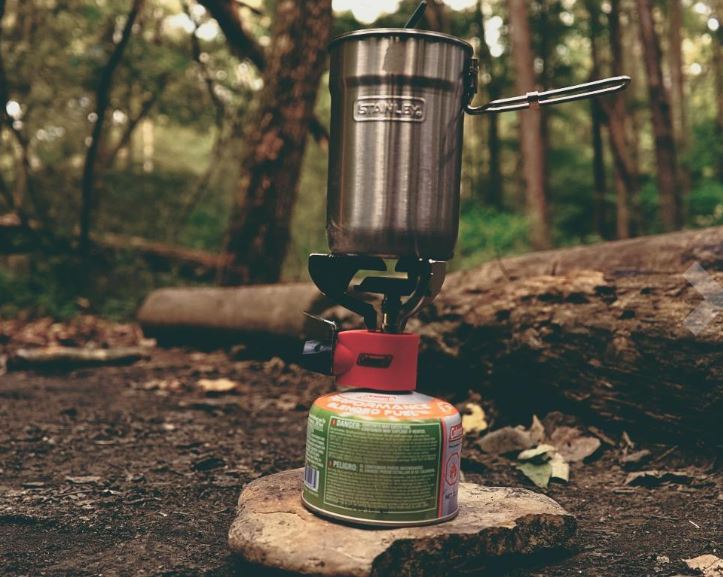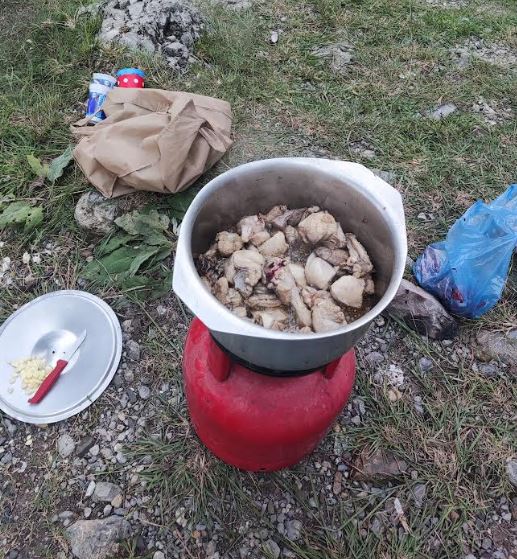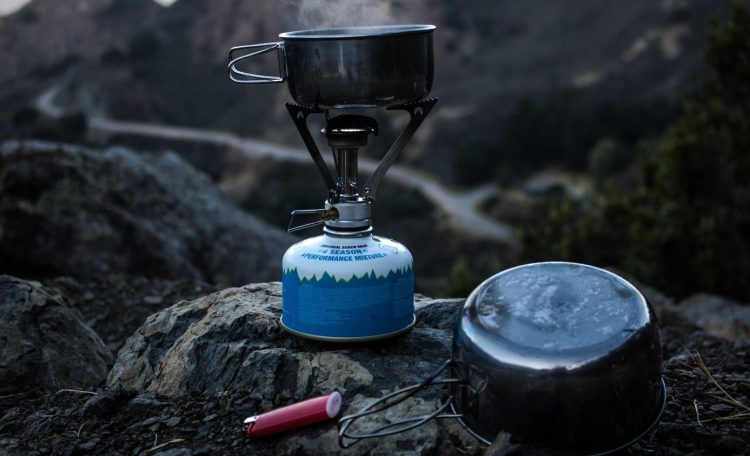Choosing between a single or a dual-fuel camping stove is a bit confusing for newbies. I know that choosing the right type of camping stove has a significant impact on the cooking options and efficiency of the outdoors. So, I’ve written this comprehensive guide to help you choose between these two stove types based on the performance, benefits, and limitations that they offer.
Dual-fuel camping stoves have gained a lot of popularity among outdoor enthusiasts who prefer cooking solutions with multiple fuel types. Whereas single fuel camping stoves show up as a great option for those who need classic and easy-to-carry equipment on a camping trip.
Dual VS Single Fuel Camping Stoves
Dual-Fuel Camping Stove
Dual-fuel stoves are the most innovative and versatile cooking equipment designed for two or more fuel types. Usually, this type of stove is compatible with two or more fuel types. For example, a typical dual-fuel stove supports butane or propane fuel at the same time.

Some stoves also support kerosine, methane, and unleaded gasoline fuel types. The adaptive nature of dual-fuel stoves allows outdoor enthusiasts to choose the fuel that goes in accordance with the environment.
Single Fuel Camping Stove
As the name suggests, single-fuel stoves are solely designed for a specific fuel type. You can either burn propane, butane, methane, kerosene, or gasoline at a single time. These are ideal for campers who require a simple and easy-to-use stove for cooking.

So, dual-fuel camping stoves allow you to switch between multiple fuel types as compared to single-fuel stoves. This makes the dual-fuel stoves a great option if you are traveling to areas where fuel options are limited.
On the other hand, single-fuel stoves are focused on a particular fuel type, therefore, these could be more efficient in that particular fuel type as compared to dual-fuel stoves.
Single-fuel stoves can result in better combustion when it comes to burning a specific type of fuel. But as these types of stoves only support a particular type of fuel, you may run up difficulties carrying these into areas where there’s no availability of such type of fuel that your stove supports.
Heat Efficiency & Cooking
A dual-fuel camping stove can burn multiple fuels, therefore, the heating efficiency of a dual-fuel stove is higher than a single-fuel stove. Similarly, the boiling time or cooking speed on a dual-fuel stove is much higher if you opt for higher BTU fuel types.
The heat output and cooking time on a single-fuel stove would depend upon the type of fuel that is being used. For example, if you have a single-fuel stove that runs on propane fuel, then you will experience higher heat output and rapid cooking time.
So, the heating efficiency, boiling, or cooking time on dual or single-fuel stoves depends upon the type of fuel used in them.
Portability and Weight
If we talk about portability, then dual-fuel stoves are heavier as they have inside them different mechanisms to support multiple fuel types.
There are different types of fuel pumps, injectors, or regulators inside a dual-fuel stove to handle different fuels. Therefore, dual-fuel stoves are bulkier and heavier to carry on a camping trip.
On the contrary, single-fuel stoves have less mechanism packed inside them as they just run on a specific type of fuel. So, the lighter construction makes them more compact and lightweight in nature as compared to dual-fuel stoves.
Streamlined construction on a single-fuel stove makes it a great deal for hikers or backpackers looking to go outdoors with minimal gear and weight load.
So, dual-fuel stoves, although, they offer more convenience when it comes to fuel compatibility, also add extra weight to your backpack. Single-fuel stoves on the other hand are compact and lightweight in nature.
Therefore, when choosing between a single or dual-fuel camping stove, it’s essential to put in front your cooking needs and portability. If you do not care about the weight and dimensions, then go with the dual-fuel stoves.
On the other side, if you don’t want to carry a lot of weight on your back and keeping your gear minimal is essential, then there’s no better deal than a single-fuel stove.
Convenience & Maintenance
I mean what could be more convenient than having a stove that supports various fuel types, right? If you are traveling in remote outbacks or internationally, then a dual-fuel stove could be the right option to have with you.
You really don’t want to end up in a situation where there’s limited or no fuel available for your stove. But refilling fuel in a dual-fuel stove could be a hectic job, but you get used to it over time.
When it comes down to maintenance, it’s a bit difficult to clean and maintain a dual-fuel camping stove. As there are a lot of valves, lines, and injectors, present inside these stoves, it takes a lot of time and effort to keep them clean.
Using different types of fuels can lead to residue buildup in a short time. And if you don’t care about your dual-fuel stove regularly, then you may end up blocking the fuel lines or valves.
Where single-fuel stoves are not as convenient as dual-fuel stoves, they are much easier to clean and maintain for longevity. With minimal parts inside, you can easily clean the whole stove in no time.
As single-fuel stoves only burn a specific type of fuel, the residue buildup on these stoves is fairly less as compared to dual-fuel stoves.
Environmental Impact
The environmental impact of single and dual-fuel stoves depends upon the type of fuel used in them. Fuels like white gas and kerosene burn cleanly and emit fewer pollutants into the air.
On the other side, fuels like diesel, gasoline, and oil are responsible for polluting most of the atmosphere. Make sure you use fuels with low carbon emissions in order to have less impact on the environment.

Propane is the most environmentally friendly fuel with lower emissions and cleaner combustion. Similarly, stoves fueled by alcohol have low carbon emissions making them eco-friendly for campers and backpackers.
Ultimately, the dual fuel vs. single fuel choice should take into account your commitment to minimizing your ecological footprint and the availability of cleaner fuel options.
Cost
As there are a lot of components involved in building a dual-fuel stove, the price tag that comes with them is typically higher as compared to single-fuel stoves. Additional pumps, valves, injectors, and regulators increase the overall cost of a dual-fuel stove.
Single-fuel stoves typically have a lower initial cost since they are designed for a specific fuel source. Also, you really don’t need additional accessories to run a single-fuel stove, so the overall investment in a single-fuel stove reduces to a significant level.
Conclusion
After going through the comparison between dual-fuel and single-fuel camping stoves, it’s clear that both options have their own set of Pros and Cons.
Choose a Dual Fuel Camping Stove If:
- Versatility Matters: If you frequently explore diverse environments with varying fuel availability, a dual-fuel stove offers the adaptability you need. This option allows you to optimize performance by selecting the most suitable fuel type for each adventure.
- Performance in Extreme Conditions: For cold weather or high-altitude expeditions, a dual-fuel stove with the option for white gas or kerosene can provide efficient heating even in challenging conditions.
- Long-Term Cost Savings: If you can take advantage of cheaper or more accessible fuel options in different locations, the adaptability of dual-fuel stoves can lead to cost savings over time.
Choose a Single Fuel Camping Stove If:
- Simplicity is Key: If you value straightforward operation and maintenance, a single-fuel stove eliminates the complexities of dealing with multiple fuel types. This simplicity can enhance your overall camping experience.
- Weight Matters: If you’re a backpacker or minimalist camper aiming to reduce the weight of your gear, a single-fuel stove’s lightweight design aligns with your mobility-focused approach.
- Environmental Consciousness: Opt for a single-fuel stove that utilizes cleaner-burning fuels like propane or alcohol if reducing your ecological footprint is a priority.

Hi, I’m Masab Jamal, the founder and head editor of this blog. I love to spend most of my time in the wilderness. Apart from camping and outdoor life, I’m a full time blogger.

